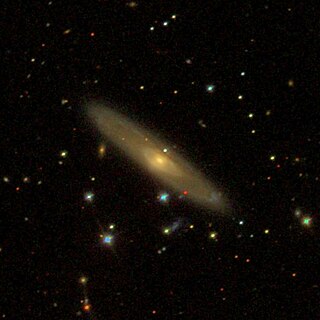
NGC 13 is a spiral galaxy in the constellation Andromeda. It is estimated to be about 220 million light-years away from the Sun. It was discovered on November 26, 1790, by William Herschel.
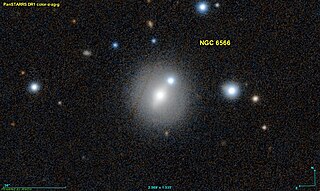
NGC 6566 is a compact elliptical galaxy within the constellation Draco. It is located about 250 million light-years away from the Sun. It was discovered on October 27, 1861 by the astronomer Heinrich d'Arrest.
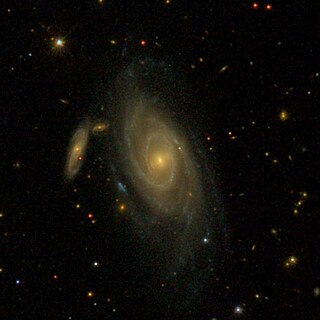
NGC 36 is a barred spiral galaxy in the constellation Pisces. It is located about 221 million light-years away. It was discovered in October 25, 1785, by the astronomer William Herschel.

Arp 271 is a pair of similarly sized interacting spiral galaxies, NGC 5426 and NGC 5427, in the constellation of Virgo. It is not certain whether the galaxies are going to eventually collide or not. They will continue interacting for tens of millions of years, creating new stars as a result of the mutual gravitational attraction between the galaxies, a pull seen in the bridge of stars already connecting the two. Located about 130 million light-years away, the Arp 271 pair is about 130,000 light-years across. It was originally discovered in 1785 by William Herschel. It is speculated, that the Milky Way will undergo a similar collision in about five billion years with the neighbouring Andromeda Galaxy, which is currently located about 2.6 million light-years away.

NGC 3260 is an elliptical galaxy in the constellation Antlia. It is a member of the Antlia Cluster, which lies about 40.7 megaparsecs away. It was discovered on May 2, 1834 by the astronomer John Herschel.

NGC 5970 is a large barred-spiral galaxy located about 90 million light years away in the constellation Serpens Caput. It appears to have two satellite or companion galaxies. It is a member of the Virgo Cluster of galaxies. It was discovered on March 15, 1784, by the astronomer William Herschel.

NGC 3738 is a dwarf galaxy in the constellation of Ursa Major and belongs to the M81 Group of galaxies. NGC 3738 is 12 million light-years from the Sun. The galaxy was first discovered by astronomer William Herschel in 1789. NGC 3738 is a blue compact dwarf, which is small compared to large spiral galaxies. The galaxy is about 10,000 light-years across. It is one-tenth the size of the Milky Way.

NGC 114 is a barred lenticular galaxy located in the constellation Cetus. It was discovered by American astronomer Truman Henry Safford on September 23, 1867. The galaxy lies approximately 195 million light-years from Earth, and is about 55,000 light-years in diameter, nearly half the size of the Milky Way.

NGC 115 is a barred spiral galaxy located in the southern constellation of Sculptor. It was discovered by the British astronomer John Herschel on September 25, 1834. The galaxy is approximately 85 million light-years from the Sun, and is about 50,000 light-years in diameter, nearly half the size of our home galaxy, the Milky Way.

NGC 468 is a spiral galaxy in the constellation Pisces. Located approximately 209 million light-years from Earth, it was discovered by John Frederick William Herschel in 1827.

NGC 471 is a lenticular galaxy located about 168 million light-years away from Earth in the constellation Pisces. It was discovered by the German astronomer Albert Marth on November 3, 1864.
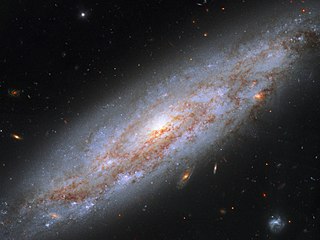
NGC 3972 is a spiral galaxy located in the northern constellation of Ursa Major. It was discovered by William Herschel on April 14, 1789. This galaxy is located 66 million light years away and is receding with a heliocentric radial velocity of 846 km/s. It is a member of the NGC 3992 Group of galaxies.

NGC 3794, also cataloged in the New General Catalogue as NGC 3804, is a low-surface-brightness galaxy in the constellation Ursa Major. It is very far from Earth, with a distance of about 68,470,000 light-years (20,990,000 pc). It was discovered on April 14, 1789, by the astronomer William Herschel.
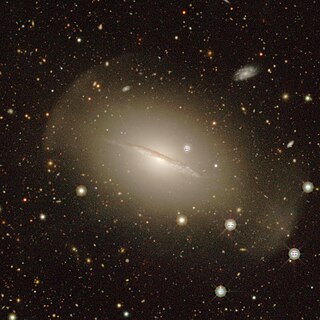
NGC 681 is an intermediate spiral galaxy in the constellation of Cetus, located approximately 66.5 million light-years from Earth.
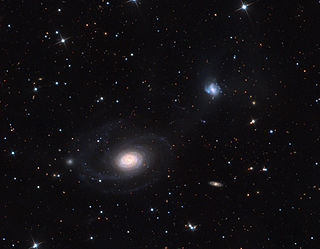
NGC 2460 is an unbarred spiral galaxy in the constellation Camelopardalis. It was discovered by German astronomer Wilhelm Tempel on August 11, 1882.

NGC 2300 is a lenticular galaxy in the constellation Cepheus. Its velocity with respect to the cosmic microwave background is 1876 ± 7 km/s, which corresponds to a Hubble distance of 90.2 ± 6.3 Mly (27.67 ± 1.94 Mpc). However, 11 non redshift measurements give a distance of 131.98 ± 21.75 Mly (40.464 ± 6.668 Mpc). The galaxy was discovered in 1871 by French astronomer Alphonse Borrelly using an 18 cm telescope.

NGC 823, also known as IC 1782, is an unbarred lenticular galaxy in the constellation Fornax. It is estimated to be 194 million light-years from the Milky Way and has a diameter of approximately 100,000 light years. NGC 823 was discovered on October 14, 1830, by astronomer John Herschel.
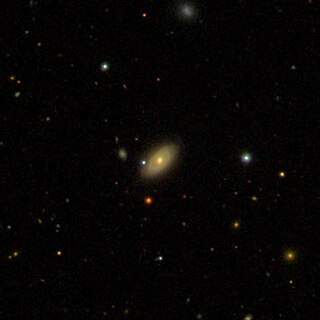
NGC 3008 is a lenticular galaxy with an active galactic nucleus in the constellation of Ursa Major, discovered by William Parsons and his assistants. It is about 40 thousand light years across, and with a recessional velocity of about 4,785 kilometers per second, is at a distance of 240 million light-years from the Sun.

NGC 5966 is an elliptical galaxy in the constellation Boötes. NGC 5966 is its New General Catalogue designation. The galaxy was discovered by William Herschel on March 18, 1787. Based on its redshift, it is located about 220 million light-years away from the Sun.

NGC 3902 is an intermediate spiral galaxy in the constellation Leo. It was discovered on April 6, 1785, by William Herschel and observed on February 19, 1827, by John Herschel. It is estimated to be 180 to 185 million light-years away, and its redshift-independent distance estimates to about 185 to 240 million light-years. It is around 75,000 light-years in diameter.




















